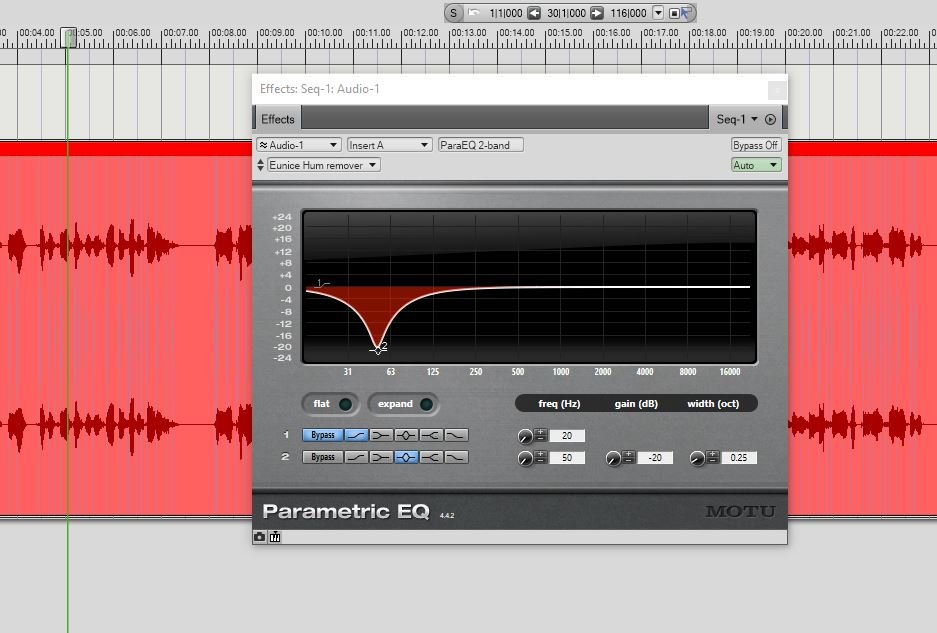50 Hz hum is an old friend to recording engineers or maybe 60Hz for our higher frequency neighbours and we often find ourselves trying to bolt the door on it during recording or trying to get rid of it in post. This week I’ve been sent some files with some hum problems and I thought I would pick up a few tools and see what’s what. In no particular order I tried, Acoustica’s Restoration plug in – Wavelab’s Sonnox and finally some good old fashioned EQ in Digital Performer.
In Wavelab Pro you get the Sonnox De-Buzzer in the box and it is simple to use despite it’s power. First choose Hum or Buzz and then find your hum frequency. Auto will do the hard work for you, and if you look closely at the frequency control in the screen capture above you can just see the white frequency adjacent to the red indicator. Fire up the tone which will help you put a sound to your display.
You may want Freeze (ie freeze the frequency) if you want to render out the file as the Auto circuit may take a short time before fixing on the offending frequency. If you engage the fine adjust setting you automatically switch to Freeze as you are by definition selecting the frequency you want to act on. Once you have the frequency dialed in then Attenuation controls the amount of signal cut while sensitivity is a kind of threshold thing. Read the help text like I did! In Hum mode the De-Buzzer will remove harmonics up to 800Hz – the more vicious Buzz mode extends that up to 4KHz – but you are in danger of savaging your signal.
Looking at the Sonnox page if you buy the stand alone De-Buzzer you get a few more bells and whistles – a spectragram display map for starters but I’m not complaining as the results in Wavelab seem pretty good. One of the nice features of WL is the ability to listen to the audio the plugin is removing – which is great when you want to reassure yourself that the processing isn’t hurting your precious sound. You get a visual indication of how much processing is going on via the Reduction meter.
I’ve been using Acon’s Acoustica Premium for a while now and it comes with the plug-ins you can also source in their Restoration Suite which has been updated to version 1.8. My plug-in is the older version but as my hum problems were fairly bog standard I thought I would give it a whirl.
Here it is in the same file in Wavelab. As you can see DeHum comes with a nice spectral overview and you can clearly see the 50Hz hump. Acon give you the facility to remove harmonics and only the odd harmonics if that is where the damage is. I asked Stian at Acon when I might these and his answer is – The “only odd harmonics” option is useful when an AC signal is symmetrically distorted in which case only odd harmonics will be produced. So now you know – just press the button and try it I say.
As you can see the plug in comes with the option of auditioning the audio that it is removing. DeHum does a great job and I liked the fact that it respects your audio – the default processing is subtle and doesn’t put your sound through a dsp mangle – you have the option to go aggressive if you need to but in my simple case it just wasn’t necessary. The difference between the two is instructive – standard mode works by modelling the hum and subtracting it from the signal, while the aggressive mode is your notch filter approach – which you can have a go at yourself with your parametric EQ as we shall see next.
Of course plugins make the modern audio world go round but suppose you just don’t have one handy – well engineers were removing hum before plugins and just about every DAW will have the EQ chops necessary to hack your hum

I’m trying to school myself to learn MOTU’s Digital Performer 9 and with the Parametric EQ offering 24 dB’s of cut and variable Q you should be able to nail your hum. If you are having trouble with identifying the exact frequency then first reverse your cut into boost (though maybe not 24 dB of boost – respect your speakers!) and sweep the boost through the problem area. It is often easier to identify your problem frequency by boosting it – then having got the numbers – apply the cut. For my simple operation this worked ok – but my programme material was speech that is going to be majorly messed with so I’m not too fussy. If I was I would stick with the plug ins – both Sonnox and Acon’s Dehum both come recommended.


